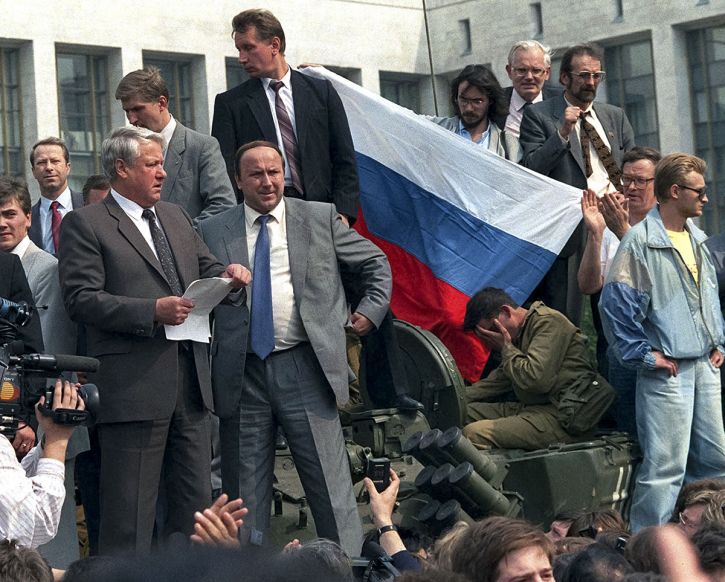25 Years After the Fall of the Soviet Union
As the world marks 25 years since the fall of the Union of Soviet Socialist Republics, let’s consider what lessons it has for us today.
Russian President Boris Yeltsin defies the August 1991 coup attempt by Communist hardliners. 
My wife and I were living in France at the time and saw a part of the chaotic fall in person. We were visiting Helsinki, Finland, and then made the roughly five-hour drive to Leningrad. We arrived in Leningrad (now, once again, St. Petersburg) just two days after the August 1991 failed coup attempt against Soviet President Mikhail Gorbachev.
Prelude to a fall
For a number of years, the cost of keeping its military on par with the United States had been pushing the inefficient, centrally controlled Soviet economy to the breaking point. Many analysts believe that Ronald Reagan’s initiation of the Strategic Defense Initiative (mocked by detractors as a kind of “Star Wars” project) caused the Soviets to conclude they had lost the Cold War.
Because they believed that SDI made military competition with the U.S. impossible, in 1985 Mikhail Gorbachev and his regime tried adopting new strategies of market-oriented policies and allowing small advances in civil liberties.
This began a series of unintended consequences. Political upheaval began as nationalist uprisings and ethnic conflicts broke out. By 1988, the Politburo in Moscow was losing control of its empire. In 1990 the republics that made up the Eastern Bloc began breaking with Moscow (starting with Estonia, Lithuania, Latvia and Georgia). In March 1990 Soviet Russia held (relatively) free elections that brought Boris Yeltsin to its newly created presidency.
Finally on Aug. 19, 1991, a group of generals opposed to the reforms and the gradual dismantlement of the U.S.S.R. attempted a coup against Mikhail Gorbachev (president of the U.S.S.R.). Three days of chaos ensued. The coup ultimately failed, due in large part to opposition from Mr. Yeltsin (president of Russia), who stood on a tank in front of the Russian parliament and encouraged the Russian people to resist.
A view from within
Two days after the failed coup, we drove across the Russo-Finish border. The guards who checked our visas told us they were not allowed to put a Soviet stamp in our passports. But they did so anyway because, as they said, the Soviet Union would soon disappear and the rules would no longer apply.
Arriving in the historic city to visit volunteers at Radio Leningrad, we found a population intoxicated with joy—and (in true Russian style) quite a lot of vodka. The people with whom we spoke told us this was the end of the hated Communist system and a chance for liberation from the oppression of the previous 70 years.
Only a few years prior, it had seemed impossible that the Soviet Union would crumble and dissolve. Yet, just like all other great empires throughout history, it did fall.
The hardships posed by the dictatorship were obvious. The historic architecture of St. Petersburg, the capital of Russia for 200 years until the Bolshevik Revolution, was literally crumbling. Lines of people waiting to buy scarce goods stretched for city blocks. The desire for hard currency was so high that the street exchange rate for our French francs and German marks was astounding. A multicourse meal, including salmon caviar and champagne, cost us the equivalent of $2.
We were witnessing the collapse of the Soviet Communist system. It had built one of the largest nuclear arsenals in the world and dominated client states in Eastern Europe, the Caribbean, Asia and Africa. Yet it fell in the course of just a few years.
Only a few years prior, it had seemed impossible that the Soviet Union would crumble and dissolve. Yet, just like all other great empires throughout history, it did fall. Unseen and misunderstood forces sapped it from within.
A lesson for today’s superpower
After the fall of the Soviet Union, the United States was left as the world’s only remaining superpower. Today the U.S. is still wealthier and more militarily powerful than the rest of the world. Its cultural influence is omnipresent. To many, it seems that the U.S. will maintain that dominance indefinitely.
But there are ominous signs that this will not remain true. There are geopolitical indicators that the U.S. is a superpower on the wane. A few of those factors are a resurgent and hostile China, a rising disdain of anything American in many parts of the world, and a disappearing will to assert American power to advance democratic values in the world. But, in my view, the greatest threat to American influence is its increasing polarization.
The recent presidential election has highlighted clashing worldviews of the American population. There is intense disagreement on issues such as “illegal alien” status, immigration, the importance of law and order, abortion, environmentalism, the definition of marriage, gender and sexual norms and religious freedom. Public discourse reveals strong feelings of revulsion, disdain and, in some cases, outright hatred of people on the other side.
Jesus stated: “Every kingdom divided against itself is brought to desolation, and every city or house divided against itself will not stand” (Matthew 12:25). Can anyone deny that the United States is increasingly a house divided? Can the nation expect the blessing and protection of the God it aggressively rejects?
The fall of the Soviet Union reminds us that great nations, even empires, can fall precipitously and that such falls are often preceded by inner strife. Americans would be wise to not forget the lessons of how great powers in the past have fallen.
For further insight into the issues facing America today, read “Why Is God Angry With America?”
Date Posted: December 26, 2016

 by Joel Meeker
by Joel Meeker

